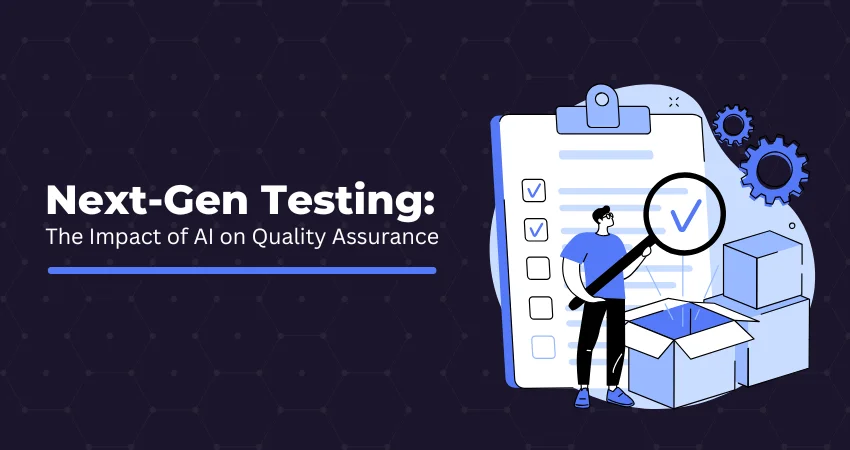Next-Gen Testing: The Impact of AI on Quality Assurance

Next-Gen Testing: The Impact of AI on Quality Assurance
Quality Assurance (QA) has always been essential for delivering reliable, secure, and high-performing applications in the ever-evolving field of software development. However, traditional testing techniques often struggle to keep up with rapid technological advancements and increasing application complexity. This is where Artificial Intelligence (AI) steps in, revolutionizing software testing and quality assurance.
What is AI-Driven Testing?
AI-driven testing refers to the use of machine learning (ML), natural language processing (NLP), and data analytics to optimize, automate, and enhance software testing. Unlike traditional methods that rely on manually created test cases or static scripts, AI-based systems can learn from application behavior, historical defects, and user interactions. They can predict issues, generate test cases, and adapt automatically to changes in the application.
Key Benefits of AI in Software Testing
1. Scalable Test Automation
AI enhances test automation by generating, maintaining, and executing scripts based on real-time changes in the application. This reduces the manual effort required for regression testing and makes it easier to scale automation across large and complex systems.
2. Smart Test Case Generation
AI tools can analyze requirements, user stories, and historical test data to automatically generate relevant test cases. This ensures better test coverage and minimizes the risk of missing critical test scenarios.
3. Faster Defect Detection
AI can identify defect-prone areas by learning from past test outcomes, allowing QA teams to focus testing where it's most needed. AI models can forecast where bugs are likely to occur, improving the overall efficiency of the testing process.
4. Efficient Test Maintenance
Maintaining test scripts is a major challenge in automated testing. AI addresses this by automatically updating test scripts when UI or functionality changes are detected, reducing flakiness and keeping tests accurate and up-to-date.
5. Visual and UI Testing
AI-powered tools can perform visual validation by comparing expected and actual screenshots using image recognition. This helps catch layout inconsistencies, rendering issues, and unexpected UI changes that traditional tests might overlook.
6. Risk-Based Testing Optimization
AI can prioritize tests based on risk. By analyzing recent code changes and impact areas, it determines which tests are most critical to run—optimizing test cycles and accelerating time-to-market.
Use Cases and Tools
Common Use Cases
- Continuous testing in CI/CD pipelines
- Regression testing for frequently updated applications
- Testing data-intensive and dynamic applications (e.g., e-commerce, fintech)
- Visual/UI testing across various devices and browsers
- Real-time monitoring and anomaly detection in production
Popular AI Testing Tools
- Testim – AI-powered test case creation and maintenance
- Mabl – Combines ML with automation for quick feedback
- Applitools – Specializes in visual AI for UI testing
- Functionize – Uses NLP and ML for large-scale test execution
- Selenium + AI integrations – Traditional frameworks enhanced with AI for smarter script generation
Challenges and Considerations
While AI brings many benefits to QA, it's not without challenges:
- Data Dependency: AI needs high-quality data to be effective. Poor or insufficient data can lead to inaccurate results.
- Initial Setup Costs: Implementing AI tools requires investment in infrastructure, tools, and team training.
- Interpretability: Understanding AI-driven decisions and predictions can be difficult for non-technical stakeholders.
- Legacy System Compatibility: Older systems may require significant updates to support AI-driven testing.
The Future of AI in QA
The integration of AI in QA is still in its early stages. Looking ahead, we can expect:
- Autonomous testing agents that interact with applications like real users
- Self-healing test scripts that automatically adapt to code changes
- AI-generated release confidence scores based on historical and real-time data
- Integration with DevOps observability tools for proactive testing insights
As AI tools become smarter and more accessible, QA teams will evolve from being test executors to strategic quality enablers, focusing on value, insight, and speed.
Final Thoughts
AI is no longer just a buzzword in the QA space—it's a transformative force. By integrating AI into testing processes, organizations can accelerate releases, improve coverage, reduce costs, and deliver higher-quality software. While the transition has its challenges, the benefits are clear.
For QA professionals, the path forward involves embracing AI tools, understanding how they complement traditional methods, and actively shaping the future of AI-driven software quality assurance.